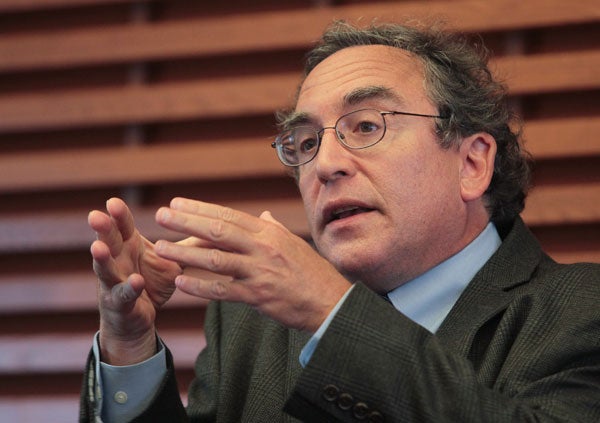|
July 5, 2012
Stanford summit brings together leaders in social sciences
The Center for Advanced Study in the Behavioral Sciences at Stanford recently held its first conference in nearly six decades, with talks on topics ranging from aging to Facebook. By Max McClure

Stanford communication Professor Cliff Nass addresses the CASBS symposium. (Photo: Mathew Sumner / Courtesy of Stanford University)
Stanford's Center for Advanced Study in the Behavioral Sciences, or CASBS, has a slightly monastic feel. It's a palatial compound on a hill to the east of the university, a tranquil retreat for prominent scholars of the humanities and social sciences, including not a few Nobel laureates, Pulitzer Prize winners and MacArthur Fellows.
Last week, for the first time in its 58-year history, CASBS stepped down from the mountaintop to host a social sciences summit. Comprising a smorgasbord of talks by experts in fields from game theory to workplace politics, the daylong conference also featured keynote addresses from New Yorker staff writer Malcolm Gladwell and Harvard psychology Professor Steven Pinker.
Emails are stupid
The brief, interactive talks leaned toward the love triangle underlying modern society: the individual, other humans and technology.
Gladwell touched on the issue in his wide-ranging opener, suggesting that a "digital preference" for networks has caused many organizations to shift, at least temporarily, away from traditional hierarchies.
Stanford communication professor and speaker Clifford Nass, who has made a career out of examining human-technology interactions, took a slightly darker view. While he discussed the promise held by increasing collaborations with machines, Nass also warned of the brain-ravaging effects of increasing media consumption.
"Companies now create policies that force their employees to multitask," he said. "It's an OSHA [occupational safety and health] problem. It's not safe for people's brains."
Nass has previously shown that media multitasking, such as surfing the Internet while working, results in diminished performance in a number of cognitive tasks.
Consumption of multiple media streams is increasingly popular, Nass explained, and seems to be tied to a desire to be distracted – a desire that makes people drop their work as soon as a new email comes in.
"There's a personality associated with heavy multitaskers," he said. "They tend to believe that new things are better than old things. Of course, with emails there's no evidence of that. The vast majority of emails are stupid."
Facebook for hunter-gatherers
In contrast, James Fowler, professor of medical genetics and political science at the University of California-San Diego, demonstrated a way in which new technologies haven't changed human behavior, but have instead helped reveal some fundamental, ancient tendencies.
Fowler studies social networks, which naturally leads him to Facebook as a source of data. His research into how even peripheral connections in a social network may influence behavior – for instance, having an obese friend of a friend makes a person 10 percent more likely to be obese – has made extensive use of Facebook's massive user base.
"As a matter of fact, if I have all the information about all of your friends, I can better predict your behavior than if I know everything about you," Fowler said.
But, perhaps more surprising, Fowler's Facebook data outline a social networking pattern that seems more or less constant across cultures.
Fowler's research on the Hadza, a hunter-gatherer people from Tanzania, shows that their social networks have strong structural similarities to the network of the average Facebook user.
"We're a lot more similar than we appear," Fowler said.
The twilight years
The work of psychology Professor Laura Carstensen, director of the Stanford Center on Longevity, focuses on a dramatic scientific advance that is almost taken for granted now – the extension of the average human lifespan.
To drive home the magnitude of the achievement, she said, "More years were added to average life expectancy in the 20th century than all the years added during all the other millennia in human history."
Of course, this remarkable advance has brought a whole new set of problems to the fore – "arguably one of the greatest challenges of the 21st century," as Carstensen put it. By 2030, a fifth of the U.S. population will be over 65.
But, as Carstensen's research into longevity and emotional health has shown, old age doesn't have to be twilit. While seniors demonstrate cognitive decline in some areas, they show increased abilities in others, such as the ability to remember information with positive associations. And Carstensen feels that popular concern over aging workforces is similarly overstated – the job market, she said, is not a zero-sum game.
The summit was sponsored primarily by SAGE Publications.
-30-
|